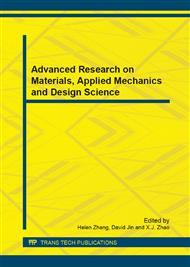[1]
C. Mattheck, S. Burkhardt, A new method of structural shape optimization based on biological growth. Int. J. Fatigue. 12 (1990) 185-190.
DOI: 10.1016/0142-1123(90)90094-u
Google Scholar
[2]
A. Baumgartner, L. Harzheim, C. Mattheck, SKO: Soft Kill Option. The biological way to find an optimum structure topology. Int. J. Fatigue. 14 (1992) 387-393.
DOI: 10.1016/0142-1123(92)90226-3
Google Scholar
[3]
C. Mattheck, Design in nature – learning from trees. Springer, Berlin Heidelberg New York, 1998.
Google Scholar
[4]
C. Mattheck, K. Bethge, The structural optimization of trees. Naturwissenschaften. 85 (1998) 1-10.
Google Scholar
[5]
Y. M. Xie, G. P. Steven, A simple evolutionary procedure for structural optimization. Comput. Struct. 49 (1993) 885-896.
DOI: 10.1016/0045-7949(93)90035-c
Google Scholar
[6]
M. Heller, R. Kaye, L. R. Rose, A gradientless finite element procedure for shape optimization. The Journal of Strain Analysis for Engineering Design. 34 (1999) 323-336.
DOI: 10.1243/0309324991513669
Google Scholar
[7]
W. Waldman, M. Heller, G. X. Chen, Optimal free-form shapes for shoulder fillets in flat plates under tension and bending. Int. J. Fatigue. 23 (2001) 185-190.
DOI: 10.1016/s0142-1123(01)00011-1
Google Scholar
[8]
M. Heller, M. McDonald, M. Burchill, K. Watters, F-111 airframe life extension through rework shape optimization of critical features in the wing pivot fitting. In: 6th Joint FAA/DoD/NASA Aging Aircraft Conference, September, San Francisco, California, 2002, pp.16-19.
DOI: 10.1142/9789812777973_0089
Google Scholar
[9]
E. Schnack, An optimisation procedure for stress concentrations by the finite element technique. Int. J. Numer. Meth. Engng. 14 (1979) 115-124.
DOI: 10.1002/nme.1620140109
Google Scholar
[10]
Y. L. Hsu, S. D. Sheppard, D. J. Wilde, The curvature function method for two-dimensional shape optimization under stress constraints. Comput. Struct. 49 (1995) 885-896.
DOI: 10.1016/0045-7949(94)00490-t
Google Scholar
[11]
A. E. Tekkaya, A. Güneri, Shape optimization with the biological growth method: a parameter study. Engineering Computations. 13 (1996) 4-18.
DOI: 10.1108/02644409610152989
Google Scholar


